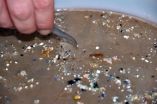(Press-News.org) Circulating tumor cells captured with a microchip-based device developed at the Massachusetts General Hospital (MGH) Center for Engineering in Medicine and the MGH Cancer Center can be cultured to establish cell lines for genetic analysis and drug testing. In the July 11 issue of Science, an MGH research team reports that the cultured cells accurately reflect a tumor's genetic mutation over time and changing susceptibility to therapeutic drugs.
"We now can culture cells from the blood that represent those present in metastatic deposits, which allows testing for drug susceptibility as the tumor evolves and acquires new mutations," says Shyamala Maheswaran, PhD, of the MGH Cancer Center, co-senior author of the Science paper. "We need to improve culture techniques before this is ready for clinical use, and we are working on doing that right now."
Circulating tumor cells (CTCs) are living solid-tumor cells that break off from either a primary or metastatic tumor and are carried through the bloodstream in extremely small quantities. The current version of the MGH-developed device, called the CTC-iChip, does not rely on prior identification of marker proteins on the surface of tumor cells, a limitation of previous versions of the MGH device and of the only commercially available device for capturing CTCs. Cell-surface proteins can change as tumors mutate during metastasis or in response to treatment, raising the possibility that methods targeting specific proteins may not reveal the full spectrum of CTCs.
The current study was designed to verify the ability of the CTC-iChip – first described in an April 2013 Science Translational Medicine report – to capture viable CTCs in a way that enables the establishment of cell lines that accurately represent the genetic status of all existing tumor sites and can be used for the testing of therapeutic drugs. The researchers first isolated CTCs from the blood of 36 patients with metastatic, estrogen-receptor-positive breast cancer. Long-lived cell lines were successfully established from CTCs of six patients, all of whom previously had received several courses of hormonal and other therapies. Subsequent samples taken from three of those patients were used to establish additional cell lines to track how the tumors changed during subsequent treatment.
While the MGH Cancer Center currently tests biopsy samples of nearly all solid tumors for mutations that may reveal therapeutic targets, the current technology only analyzes a limited number of genes for known mutations. Since CTC-derived cell lines allow a much more comprehensive genetic analysis, the investigators were able to screen for mutations in 1,000 known cancer-associated genes.
In addition to confirming mutations identified in biopsy samples of the patients' primary tumors, genetic analysis of CTC cell lines revealed several additional mutations, some not present in the primary. For example, one cell line showed the development of a new PI3 kinase mutation known to be a therapeutic target. In addition, a usually rare estrogen-receptor mutation, known to develop in patients treated with estrogen-blocking aromatase inhibitors (AIs), was found in CTC cell lines from three patients, all of whom had received extensive AI treatment.
Testing these CTC cell lines for drug sensitivity identified potential combinations – some involving drugs still at the investigational stage – that inhibited growth in cell lines and in mouse tumors developed from the injection of CTCs from specific patients. Some of these combinations included drugs known to inhibit proteins that were not mutated in the CTC cell lines but may otherwise contribute to tumor growth.
"This approach of culturing circulating cancer cells in the blood, analyzing them for new mutations that have developed during therapy, and testing the utility of drugs targeting those mutations could become the essence of individually adjusted cancer therapy in the future," says Daniel Haber, MD, PhD, director of the MGH Cancer Center, Isselbacher/Schwartz Professor of Oncology at Harvard Medical School (HMS) and co-senior author of the Science paper.
Adds Maheswaran, an associate professor of Surgery at HMS, "The ability to culture circulating tumor cells, do a comprehensive genetic analysis for new mutations, determine which ones are targetable and identify the most effective drug combinations could help us develop truly individualized therapeutic strategies. But this is still investigational. We hope that with further refinements it will become clinically available in the future."
In 2011 the MGH entered a collaborative agreement with Johnson & Johnson to establish a center of excellence in CTC research. Additional support for the current study includes a "dream team" grant from Stand Up to Cancer, and grants from the Breast Cancer Research Foundation, the National Institutes of Health, and the Howard Hughes Medical Institute. Patent applications have been filed for the CTC-iChip, which Johnson & Johnson will develop for commercialization.
INFORMATION:
Lead author of the Science paper is Min Yu, PhD, formerly of the MGH Cancer Center and now at the University of Southern California. Additional co-authors include Aditya Bardia, MBBS, MGH Cancer Center, and Mehmet Toner, PhD, director of the BioMicroElectroMechanical Systems Resource Center in the MGH Center for Engineering in Medicine.
Massachusetts General Hospital, founded in 1811, is the original and largest teaching hospital of Harvard Medical School. The MGH conducts the largest hospital-based research program in the United States, with an annual research budget of more than $785 million and major research centers in AIDS, cardiovascular research, cancer, computational and integrative biology, cutaneous biology, human genetics, medical imaging, neurodegenerative disorders, regenerative medicine, reproductive biology, systems biology, transplantation biology and photomedicine.
Cultured CTCs reveal genetic profile, potential drug susceptibility of breast cancer cells
2014-07-10
ELSE PRESS RELEASES FROM THIS DATE:
Inherited 'memory' of environmental impact on health may be limited
2014-07-10
When a pregnant mother is undernourished, her child is at a greater than average risk of developing obesity and type 2 diabetes, in part due to so-called 'epigenetic' effects. A new study in mice demonstrates that this 'memory' of nutrition during pregnancy can be passed through sperm of male offspring to the next generation, increasing risk of disease for her grandchildren as well. In other words, to adapt an old maxim, 'you are what your grandmother ate'. The study also raises questions over how epigenetic effects are passed down from one generation to the next – and ...
Researchers harness a powerful new source of up-to-date information on economic activity
2014-07-10
ANN ARBOR--- Researchers at the University of Michigan, University of California Berkeley, and Arizona State University have developed a new data infrastructure for measuring economic activity.
The infrastructure uses aggregated and de-identified data on transactions and account balances from Check, a mobile payments app, to produce accurate and comprehensive measures of consumers' spending and income on a daily basis.
In a paper appearing in the July 11 issue of Science, economists Michael Gelman, Shachar Kariv, Matthew Shapiro, Dan Silverman, and Steven Tadelis ...
International science team solve biological mystery
2014-07-10
This news release is available in German.
An international team of researchers, led by the University of Leicester, has solved a long-standing mystery in biology, by identifying the molecular structure of a vital biological chemical. The debate – which has raged within the scientific community for years – boils down to something as simple as a hydrogen atom: is it there, or is it not?
The controversy centres around a form of enzyme called a heme (or haem, as in haemoglobin) at the centre of which is an iron atom (Fe) called a 'ferryl' which becomes oxidised when ...
Overfishing in the English Channel leaves fisherman scraping the bottom of the barrel
2014-07-10
Decades of overfishing in the English Channel has resulted in the removal of many top predators from the sea and left fishermen 'scraping the barrel' for increasing amounts of shellfish to make up their catch.
Sharks, rays, cod, haddock and many other species at the head of the food chain are at historic lows with many removed from the area completely.
These are some of the findings of a study led by marine biologists at Plymouth University, in association with international non-profit research organization WorldFish. They analysed catches over the past 90 years and found ...
Uncertainty gives scientists new confidence in search for novel materials
2014-07-10
Scientists at Stanford University and the Department of Energy's SLAC National Accelerator Laboratory have found a way to estimate uncertainties in computer calculations that are widely used to speed the search for new materials for industry, electronics, energy, drug design and a host of other applications. The technique, reported in the July 11 issue of Science, should quickly be adopted in studies that produce some 30,000 scientific papers per year.
"Over the past 10 years our ability to calculate the properties of materials and chemicals, such as reactivity and mechanical ...
Scripps scientists discover evidence of super-fast deep earthquake
2014-07-10
As scientists learn more about earthquakes that rupture at fault zones near the planet's surface—and the mechanisms that trigger them—an even more intriguing earthquake mystery lies deeper in the planet.
Scientists at Scripps Institution of Oceanography at UC San Diego have discovered the first evidence that deep earthquakes, those breaking at more than 400 kilometers (250 miles) below Earth's surface, can rupture much faster than ordinary earthquakes. The finding gives seismologists new clues about the forces behind deep earthquakes as well as fast-breaking earthquakes ...
Leading scientists express rising concern about 'microplastics' in the ocean
2014-07-10
Microplastics – microscopic particles of plastic debris – are of increasing concern because of their widespread presence in the oceans and the potential physical and toxicological risks they pose to organisms.
This is the view of two of the world's most eminent authorities on the subject, Professor Kara Lavender Law, of Sea Education Association (Woods Hole, MA), and Professor Richard Thompson of Plymouth University (UK).
In an article published today in the journal Science, the two scientists have called for urgent action to "turn off the tap" and divert plastic waste ...
Control strategy for Dengue, malaria increases risk of West Nile virus
2014-07-10
Mosquitoes infected with the bacteria Wolbachia are more likely to become infected with West Nile virus and more likely to transmit the virus to humans, according to a team of researchers.
"Previous research has shown that Wolbachia -- a genus of bacteria that live inside mosquitoes -- render mosquitoes resistant to pathogen infection, thereby preventing the mosquitoes from infecting humans with the pathogens," said Jason Rasgon, associate professor of entomology, Penn State. "As a result, researchers are currently releasing Wolbachia-infected mosquitoes into the wild ...
New study shows drinking alcohol provides no heart health benefit
2014-07-10
PHILADELPHIA – Reducing the amount of alcoholic beverages consumed, even for light-to-moderate drinkers, may improve cardiovascular health, including a reduced risk of coronary heart disease, lower body mass index (BMI) and blood pressure, according to a new multi-center study published in The BMJ and co-led by the Perelman School of Medicine at the University of Pennsylvania. The latest findings call into question previous studies which suggest that consuming light-to-moderate amounts of alcohol (0.6-0.8 fluid ounces/day) may have a protective effect on cardiovascular ...
Study looks at how Twitter can be used to address specific health issues
2014-07-10
Childhood obesity is one of the top public health concerns in the United States, with 32 percent of youths aged 2-19 classified as obese as of 2012. As health problems such as childhood obesity grow, individuals and organizations have taken to Twitter to discuss the problem.
A new study, led by Jenine K. Harris, PhD, assistant professor at the Brown School at Washington University in St. Louis, examined the use of the hashtag #childhoodobesity in tweets to track Twitter conversations about the issue of overweight kids.
The study published this month in the American ...



